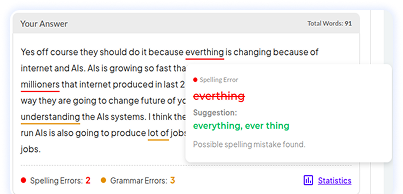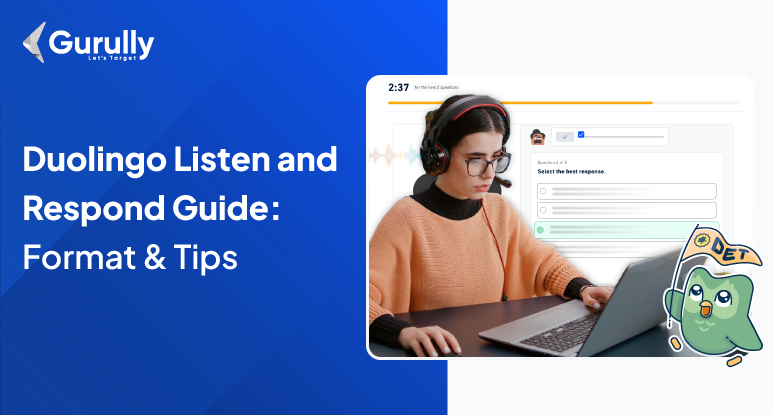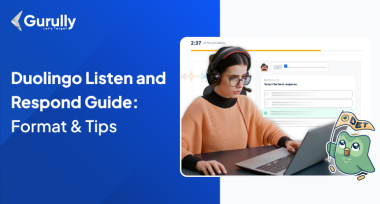Duolingo Listen and Respond task is designed to evaluate how well you understand and respond to everyday spoken English. If you are not a native English speaker, this task can be tricky. But do not worry; this blog will cover everything, from understanding the format to high-scoring tips and sample questions and answers. Bookmark this blog and learn how to perform well in this task.
What is “Duolingo Listen and Respond” Task?
In this question, you will hear a short audio clip that stimulates a real-life conversation. Your goal in the Duolingo listen and respond task is to:
- Understand the situation
- Choose appropriate way to start a conversation
- Select best response in all the stages of the interaction
This task aims to evaluate your English proficiency in real-life conversations, such as speaking to a professor, answering an interview question, or responding to a colleague.
Skills Tested:
- Listening
- What’s Tested: How accurately you hear and speak English
- How It’s Tested: You will listen to a statement or question, and after hearing it, you must understand vocabulary, pronunciation, and intonation.
- Comprehension
- What’s tested: What did you understand from the statement you heard?
- How It’s Tested: Your ability to comprehend the main idea, context, tone, and meaning of the message to give an appropriate and relevant response.
- Conversation
- What’s Tested: Your ability to respond naturally and appropriately, as in a real-life conversation.
- How It’s Tested: You must give a spoken or typed reply that is:
o Relevant to the question
o Grammatically correct
o Clear and fluent
o Demonstrates appropriate vocabulary use and tone
Take advantage of Gurully’s free mock test with instant AI-scoring and start your preparation now. 
Common Prompts You Might Hear
Here are some examples of what the speaker might say:
- “What do you usually do on weekdays?”
- “Tell me about the recent place you have visited”
- “What keeps you healthy?”
- “What do you prefer more for traveling, bike or road?”
Notice how these sound like real-world, everyday questions. Your response doesn’t need to be academic or formal—just natural and to the point.
Tips For Duolingo Listen and Respond
Improve Listening Accuracy
- Focus on the intonation, stress, and rhythm of the speaker.
- Practice with short audio clips from native speakers (e.g., TED-Ed, BBC Learning English).
- Listen for question types – Is it a question, instruction, or statement?
Think Fast – Respond Naturally
- Aim for quick, natural responses. You don’t need long answers—clarity and relevance are key.
- Practice common conversational patterns, e.g.,
o “What do you think about…?” → “I think it’s a great idea because…”
o “Can you help me with…?” → “Sure, I’d be happy to.”
Speak Clearly and Confidently
- Use a neutral accent and avoid mumbling.
- Maintain a moderate pace—not too fast or slow.
- Articulate each word clearly, especially endings (e.g., walked, plays).
Use Correct Grammar and Vocabulary
- Even short responses should be grammatically correct.
- Avoid filler words like “umm”, “you know”, or slang.
- Include basic connectors: “because”, “but”, “so”.
Stay Calm and Focused
- You can only hear the audio once, so listen carefully.
- Take a deep breath before speaking—don’t panic if you’re unsure.
- Practice thinking and speaking simultaneously under time pressure.
Train with Sample Prompts
Practice with questions like:
- “Do you prefer reading books or watching movies?”
- “Tell me about your favorite holiday.”
- “What would you do if it rains tomorrow?”
Duolingo Listen and Respond Sample Question With Answer
Sample Question 1:
A conversation between a peer tutor and a psychology student who is preparing for a research paper
JAMES: Hi Karen. Thanks for seeing me. I’m a bit stuck with my research paper. It’s about cognitive biases, but I’m not sure what I should focus on.
TUTOR: No problem. First, let’s look at your task sheet. That usually gives us some direction.
JAMES: I brought it with me. But I don’t really know how broad or narrow to go.
TUTOR: Try picking one or two specific biases to focus on. That will help you go deeper.
JAMES: I was thinking about confirmation bias … or anchoring.
TUTOR: Those are great options. Have you looked at any sources yet?
JAMES: Not really. I get overwhelmed when I try searching online.
TUTOR: That’s common. Try combining search terms like “confirmation bias in decision-making.” It helps narrow things down.
JAMES: That’s a good idea. I’ll try that.
You will participate in a conversation about the scenario below:
You will read about a conversation between a peer tutor and a psychology student who is preparing a research paper. You were unsure about the concept of cognitive biases, so you go to your tutor for guidance.
Question 1 to 5
Pick the best option to start the conversation
- Hi Karen. Thanks for seeing me.
- I’m a bit stuck with my paper.
- It’s about cognitive biases.
- I don’t really understand what that includes.
- Hi Karen. Thanks for seeing me. I’m a bit stuck with my research paper.
Ans: Hi Karen. Thanks for seeing me. I’m a bit stuck with my research paper.
TUTOR: No problem. First, let’s look at your task sheet.
Question 2 to 5
Select the best option
- I brought it with me.
- I have it here.
- I brought it with me. But I don’t really know how broad or narrow to go.
- Yes, here’s my paper.
- Sure, I printed it.
Ans: I brought it with me. But I don’t really know how broad or narrow to go.
TUTOR: Try picking one or two specific biases to focus on.
Question 3 to 5
Select the best option
- Maybe confirmation bias?
- I was thinking about confirmation bias … or anchoring.
- I don’t know what to choose.
- I’m thinking something about bias.
- I’ll pick randomly.
Ans: I was thinking about confirmation bias … or anchoring.
TUTOR: Those are great options. Have you looked at any sources yet?
Question 4 to 5
Select the best option
- Not yet. It’s confusing.
- Not really. I get overwhelmed when I try searching online.
- I’m not sure.
- No, I just asked my friend.
- I read a blog.
Ans: Not really. I get overwhelmed when I try searching online.
TUTOR: Try combining search terms like “confirmation bias in decision-making.”
Question 5
Select the best option
- That’s a good idea. I’ll try that.
- Sounds good.
- Thanks! That helps.
- I’ll search later.
- Nice.
Ans: That’s a good idea. I’ll try that.
Summarize the conversation you just had in 75 seconds.
Your response:
I talked to my tutor about my psychology paper on cognitive biases. I wasn’t sure how to narrow my topic. She suggested I focus on specific biases like confirmation bias or anchoring. I also learned how to use better keyword combinations in online searches to find more relevant information. That made things much clearer for me.
Sample Question 2:
A conversation between a peer tutor and a business student who needs help with a marketing presentation
ANITA: Hi Sam. Thanks for meeting with me. I’m really unsure about my marketing presentation.
TUTOR: That’s okay. Let’s start by looking at your assignment brief. Do you have it?
ANITA: Yes, I have it here. I need to present a product strategy, but I’m not sure how detailed it should be.
TUTOR: A good starting point is to focus on one product and apply a framework, like the 4Ps—Product, Price, Place, Promotion.
ANITA: I’ve heard of the 4Ps but haven’t used them before.
TUTOR: No problem. We can go through each step. Have you picked a product yet?
ANITA: I was thinking of using a food delivery app as my example.
TUTOR: That works well. Try searching for marketing strategies used by food delivery services and relate them to the 4Ps.
ANITA: Got it. That gives me a clear direction.
You will participate in a conversation about the scenario below:
You will read about a conversation between a peer tutor and a business student preparing for a marketing presentation. You are unsure about the structure of the presentation, so you go to your tutor for help.
Question 1 to 5
Pick the best option to start the conversation:
1. Hi Sam. Thanks for meeting with me.
2.I’m really unsure about my presentation.
3.It’s for a marketing class.
4.I have a presentation due.
5.Hi Sam. Thanks for meeting with me. I’m really unsure about my marketing presentation.
Ans: 5. Hi Sam. Thanks for meeting with me. I’m really unsure about my marketing presentation.
TUTOR: That’s okay. Let’s start by looking at your assignment brief. Do you have it?
Question 2 to 5
Select the best option:
1.Yes, I have it.
2.Yes, here it is.
3.Yes, I have it here. I need to present a product strategy, but I’m not sure how detailed it should be.
4.Sure, it’s in my folder.
5.It’s about a product.
Ans: 3. Yes, I have it here. I need to present a product strategy, but I’m not sure how detailed it should be.
TUTOR: A good starting point is to focus on one product and apply a framework, like the 4Ps.
Question 3 to 5
Select the best option:
1. I’ve heard of the 4Ps but haven’t used them before.
2. I think I know them.
3. I forgot them.
4.That’s confusing.
5.Not really sure.
Ans: 1. I’ve heard of the 4Ps but haven’t used them before.
TUTOR: No problem. We can go through each step. Have you picked a product yet?
Question 4 to 5
Select the best option:
- I was thinking of using a food delivery app as my example.
- Not yet.
- I might use something.
- A random item maybe.
- I don’t know what to choose.
Ans: 1. I was thinking of using a food delivery app as my example.
TUTOR: That works well. Try searching for marketing strategies used by food delivery services.
Question 5
Select the best option:
- Got it. That gives me a clear direction.
- I’ll do that.
- Great advice.
- That helps me.
- Sounds good to me.
Ans: 1. Got it. That gives me a clear direction.
Summarize the conversation you just had in 75 seconds
Your response:
I met my tutor to ask about my marketing presentation. I was confused about how much detail to include. My tutor advised me to pick one product and use the 4Ps framework to structure my presentation. I chose a food delivery app and was told to research how such companies market their services. That helped me understand how to proceed.
Achieving a high score on the Duolingo Exam isn’t difficult—with the right preparation strategy. Start your journey with Gurully’s full-length mock tests, designed to simulate the real exam environment. These tests help you get familiar with the tasks and offer instant AI-based scoring for quick performance feedback. Take advantage of one free mock test to assess your current preparation level and plan your next steps confidently.
Conclusion:
Duolingo Listen and Respond” task evaluates real-life communication skills through everyday conversations. To score high, improve your listening, quick thinking, clear speaking, and grammar. Use Gurully’s AI-powered DET mock tests to simulate the real exam experience, receive instant feedback, and track your progress. With consistent effort, achieving a high score becomes entirely achievable.
FAQ:
How much time do I get to respond after the audio finishes?
What are the most common mistakes test-takers make in this task?
Do I lose marks for hesitations or filler words like “umm” or “you know”?
Is it okay to repeat part of the question in my answer?
How is the scoring done for Listen and Respond?
How can I improve my Duolingo listening?
How to get 120 in Duolingo?
Also Read:
- Duolingo Listen and Type Guide To Score High
- Duolingo Read and Complete Task: Format & Sample Question With Answer To Score High
- Score High In Duolingo English Language Test With Gurully







